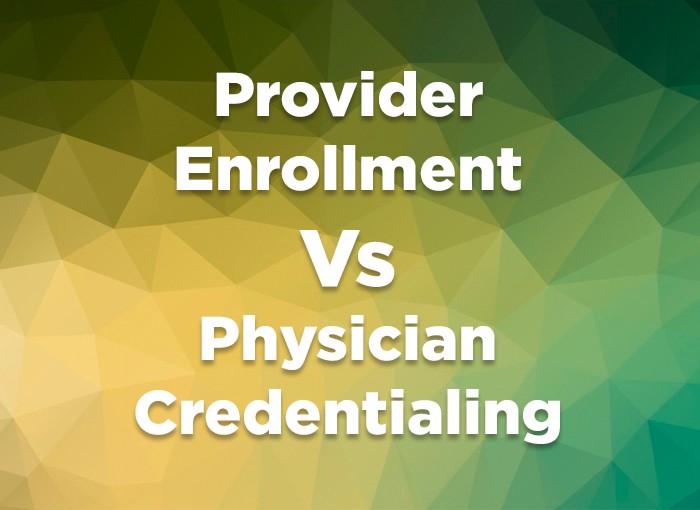Difference Between Provider Enrollment and Physician Credentialing?
In the healthcare industry, many jargons are confused with one another. One amongst them is the difference between provider enrollment and physician credentialing. Because of similar explanations mentioned at various sites, it is easy to consider both the same. However, there are specific differences between both, which have clearly been explained in this article.
What is Provider Enrollment?
“Provider enrollment”, also known as “payer enrollment”, is an application requested by healthcare providers to participate in health insurance networks. The healthcare providers who are enrolled in such healthcare insurance plans are termed as “in network” healthcare service providers.
In today’s world, most of the patients are backed by some health insurance to take care of the monetary coverage required for the treatment. Many of these insurance plans provide coverage only for enlisted healthcare providers. Additionally, healthcare providers are not obliged to make insurance claims until they have been enrolled in healthcare plans.
What is Physician Credentialing?
Physician credentialing, which is widely known as healthcare credentialing, is a verification process of the healthcare service providers. Verification of the credibility of intricate information like physician’s educational background, training, internships, residency, fellowship, license validity, etc. is included in physician credentialing. The verification is done by examining the primary source that has provided the credentials such as medical school, state licensing board, hospital, etc.
Healthcare organizations utilize the credentialing process for various purposes, such as allowing healthcare providers to practice on their campus, hiring new healthcare providers, etc.
How provider enrollment and physician credentialing are interrelated?
Physician or healthcare credentialing is a significant part of the complete provider enrollment process.
The process of provider enrollment can be bifurcated mainly into three steps:
- Filing the enrollment form
- Physician credentialing
- Contracting
How does the whole process work?
The first step of the provider enrollment process is filling the enrollment application form with insurances for requesting to join the network. The application is further processed with a thorough verification of the requester’s credentials.
The credentialing process is done by either using the unique credentialing application, or CAQH (Center for Affordable Quality Healthcare Inc) or state standardized credentialing application. The complete credentialing procedure is a long, tedious process that could take from 90 days to up to six months to complete if not taken care of meticulously. The required assimilated verification documents for credentialing are passed on to the credentialing committee for further approval.
After the healthcare service providers get approval by the credentialing committee, they are extended a contract to participate in the healthcare plans. At the contracting stage, the healthcare providers are offered the terms of the agreement, reimbursement rates, participation responsibilities, etc. Once the terms of the agreement are accepted and signed, the healthcare service providers are given the ‘agreement effective date’ and ‘provider number’ for them to start submitting the claims.
The provider enrollment process of Medicare, Medicaid, Tricare, and government health programs has some differences from the commercial insurance networks. Certain regulations have to be followed to enroll in such health programs. Some of the key points are listed below:
- A standard form has to be filled in order to become applicable for enrollment in government healthcare programs.
- The form then has to be sent to the designated intermediary, who will handle all the administrative work of the process.
- The healthcare provider must have a primary place of service, either in the final preparation stage or the operational stage.
- The healthcare provider must set EFT payment to receive the reimbursements.
- Personal information of all of the owners of the practice has to be submitted.
- Citizenship documents have to be submitted by the healthcare providers who are native Americans.
- ECFMG certificate has to be submitted by any healthcare provider whose education has not been done in the US.
Why is Provider Enrollment necessary?
Provider or payer enrollment is the foundational step of revenue cycle management. As most of the patients rely on insurance to cover their treatment charges, they prefer referring to doctors who are in the network of their insurance plans. The healthcare providers too, can’t claim any insurance bills unless and until they are enrolled in the programs. Therefore, not enrolling in such healthcare insurance programs can mean huge revenue loss for the practice.
How to participate and complete the process effortlessly and error-free?
Even though it is highly important for healthcare professionals to enroll in the insurance plans, the process could be quite cumbersome in itself. It requires undivided attention and profound knowledge of the complete process to handle each stage without committing any mistake. However, in such intricate and complex processes, errors are bound to happen. Such mistakes can extend the already long waiting period of approval.
To overcome such problems, healthcare providers now seek expert guidance and assistance for the process. Outsourcing to a company that provides these services can make the whole process more manageable resulting in quick achievement of the desired outcome.




